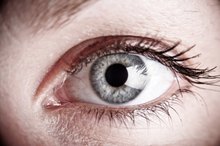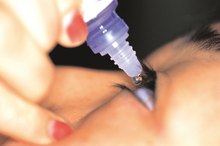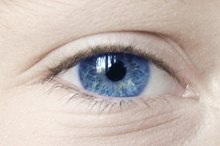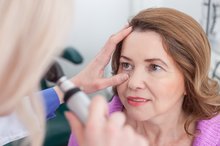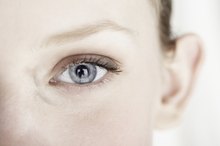What does fact checked mean?
At Healthfully, we strive to deliver objective content that is accurate and up-to-date. Our team periodically reviews articles in order to ensure content quality. The sources cited below consist of evidence from peer-reviewed journals, prominent medical organizations, academic associations, and government data.
- National Eye Institute: Facts About Dry Eye
- Linus Pauling Institute: Vitamin A
- Linus Pauling Institute: Vitamin B6
- Experimental Eye Research: Diet, Nutraceuticals and the Tear Film
- Experimental Eye Research: Diet, Nutraceuticals and the Tear Film
- Linus Pauling Institute: Folate
The information contained on this site is for informational purposes only, and should not be used as a substitute for the advice of a professional health care provider. Please check with the appropriate physician regarding health questions and concerns. Although we strive to deliver accurate and up-to-date information, no guarantee to that effect is made.
Can Vitamins Increase Risk for Dry Eyes?
Lack of tears in your eyes causes dry eyes. Proteins, minerals and vitamins are all critical for making tears, which means that a lack of vitamins could increase your risk for developing dry eyes. While almost all vitamins have roles to play, vitamin A, folate and vitamin B-6 are especially important.
Benefits of Tears
Tears moisturize your eyes and protect them from invading bacteria. They wash away dust and deliver oxygen and nutrients to the cornea. Tears also contain antibodies that prevent infection.
Your eyesight depends on tears. They create a coating over the eyes called a tear film, which is made from a combination of oil, water and mucus. This film ensures normal vision by focusing light as it enters your eyes.
When you don’t produce enough tears, or when they’re not the right mix of water, oil and mucus, you have a condition called dry eye.
- Tears moisturize your eyes and protect them from invading bacteria.
- They create a coating over the eyes called a tear film, which is made from a combination of oil, water and mucus.
Vitamin A
What Causes the Corners of the Eyes to Be Dry?
Learn More
If you get your daily vitamin A from carotenoids in fruits and veggies, you don’t have to worry about toxicity. Some of the best sources include:
- sweet potatoes
- carrots
- pumpkin
- cantaloupe
- broccoli
- spinach
- other leafy greens
Vitamin B-6
Vitamin B-6 can help protect the tear film, especially if it’s consumed at the same time as protein, according to Optometric Management. Together with vitamins A and C, vitamin B-6 ensures your eyes make enough tears.
The recommended dietary allowance for vitamin B-6 is 1.3 milligrams daily. Many breakfast cereals are also fortified with vitamin B-6.
- Vitamin B-6 can help protect the tear film, especially if it’s consumed at the same time as protein, according to Optometric Management.
- Together with vitamins A and C, vitamin B-6 ensures your eyes make enough tears.
Folate
The Best Eye Drops for Dry Eyes
Learn More
Folate helps synthesize proteins and DNA, which makes it essential for building and repairing new cells. In this role, it’s a crucial nutrient for mucous membranes in the eyes, as well as tear glands and tear ducts.
Green leafy vegetables are rich sources of folate. You’ll also get it from beans, lentils, and citrus fruits and juices. Cereals, pasta, rice and bread are good choices because they’re fortified with folate in the form of folic acid.
While getting nutrients from whole foods is always preferred, your body absorbs more of the nutrient when you consume the supplemental form, folic acid. Men and women should get 400 micrograms of folate daily.
- Folate helps synthesize proteins and DNA, which makes it essential for building and repairing new cells.
- Cereals, pasta, rice and bread are good choices because they’re fortified with folate in the form of folic acid.
Related Articles
References
- Merck Manual: Protective Features of the Eyes
- National Eye Institute: Facts About Dry Eye
- Linus Pauling Institute: Vitamin A
- Linus Pauling Institute: Vitamin B6
- Experimental Eye Research: Diet, Nutraceuticals and the Tear Film
- Linus Pauling Institute: Folate
- American Academy of Ophthalmology. What Is Dry Eye? 2019.
- Ehrhart IC, Parker PE, Weidner WJ, Dabney JM, Scott JB, Haddy FJ. Coronary vascular and myocardial responses to carotid body stimulation in the dog. Am J Physiol. 1975;229(3):754-60. DOI: 10.1155/2017/4675401
- Greiner KL, Walline JJ. Dry Eye in Pediatric Contact Lens Wearers. Eye Contact Lens. 2010;36(6):352-355. doi:10.1097/ICL.0b013e3181f8bc25
- American Optometric Association. Dry Eye.
- American Academy of Ophthalmology. Dry Eye Diagnosis and Treatment. 2020.
- American Academy of Ophthalmology. Punctal Plugs. 2020.
- de Araujo DD, Silva DVA, Rodrigues CAO, Silva PO, Macieira TGR, Chianca TCM.Effectiveness of Nursing Interventions to Prevent Dry Eye in Critically Ill Patients.Am J Crit Care. 2019 Jul;28(4):299-306. doi: 10.4037/ajcc2019360.
- Rabina G, Boguslavsky II, Mimouni M, Kaiserman I.The Association between Preoperative Dry Eye Symptoms and Postoperative Discomfort in Patients Underwent Photorefractive Keratectomy.J Ophthalmol. 2019 Feb 18;2019:7029858. doi: 10.1155/2019/7029858. eCollection 2019.
Writer Bio
Sandi Busch received a Bachelor of Arts in psychology, then pursued training in nursing and nutrition. She taught families to plan and prepare special diets, worked as a therapeutic support specialist, and now writes about her favorite topics – nutrition, food, families and parenting – for hospitals and trade magazines.
